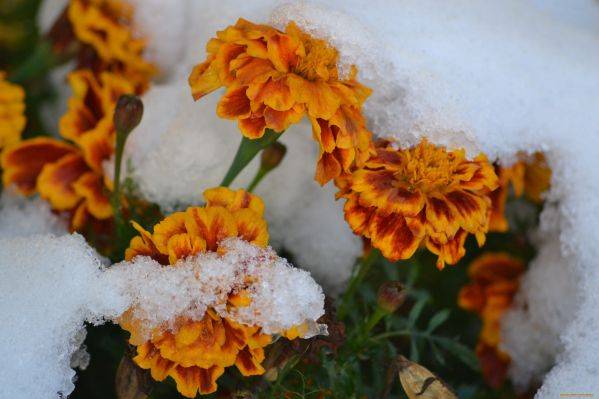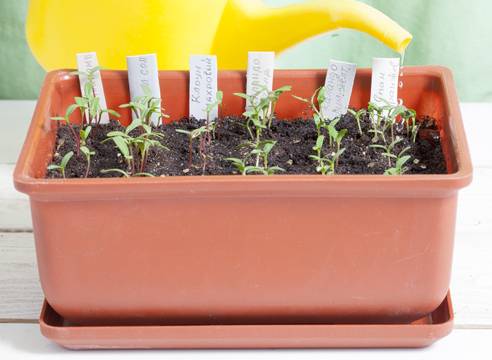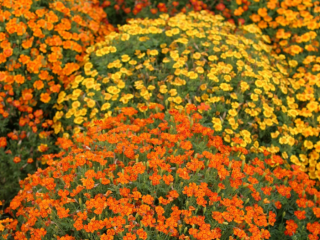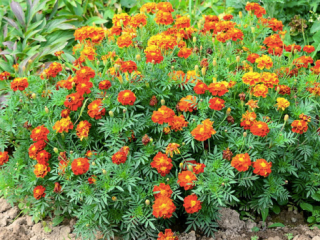Content
It is very difficult to find a person who does not know about these beautiful and picky flowers. Many countries have their own legends and myths about the appearance of Marigolds. Some peoples revere it not only for its resemblance to golden, shining coins, but also for the healing properties that these flowers, popular and widespread throughout the planet, have.
It is customary to decorate flower beds with marigolds, plant them along garden paths, they look ideal in flowerpots and flowerpots, and go very well with many plants when decorating personal plots.
And every gardener at least once in his life grew modest, and at the same time unique flowers in his garden beds. After all, these flowers perfectly repel insect pests. Moreover, growing Marigolds from seeds is such a simple undertaking that it does not cause any particular difficulties even for novice gardeners.
Familiar strangers
Few people know that the familiar Marigold has many names. The Latin name for flowers "Tagetes", that is, Tagetes, takes its roots from ancient Roman mythology. At the end of the 18th century, when they first appeared on the territory of Rus', they were called “African flowers”.In Ukraine they are known under the name Chornobrivtsi.
In the Land of the Rising Sun, Marigolds are called “flowers of ten thousand years”. In Hinduism they are also revered, and most often these flowers are personified with Krishna. And the Indians have used them since ancient times to perform special, magical rituals. In the UK, Marigold is known as 'marigold', meaning 'Mary's gold'.
Despite the wide growing area, the true homeland of Marigolds is Mexico, where these flowers grew in the vast mountainous expanses of Central and South America. Spanish conquistadors first brought Tagetes seeds to Europe in the 16th century, and subsequently they spread throughout the world.
Marigolds belong to the Asteraceae or Asteraceae family. In their historical homeland, flowers growing in the wild are perennials. But flower beds and flower beds are decorated only by annual representatives of this family.
Marigolds bloom for a very long time and abundantly. When growing flowers in seedlings, the first buds bloom in early to mid-June. Continuous flowering continues until the first autumn frosts.
At the moment, more than 40 types of Marigold flowers are known. But the following types are considered the most popular:
- Erect (African). The bushes have a dense, straight stem. The height of the plants ranges from 45-150 cm. The diameter of the inflorescences is 6-13 cm. Among them there are double, semi-double and simple flowers.
- Thin-leaved (Mexican). Marigold bushes are low, up to 20-40 cm in height, with small flowers, no more than 1.5-3 cm in diameter.
- Rejected (small-flowered or French). The height of the bushes is up to 15-50 cm. The plants grow well in width. Inflorescences no more than 4-6 cm.
- Anise. The plants emit a distinct aroma, somewhat reminiscent of tarragon.
In order to decorate your plot, you can purchase ready-made seedlings, but growing Marigold flowers from seeds at home is not such a difficult matter. It is only important to correctly determine when to plant marigold seedlings, how to care for the seedlings, and which area is best suited for flowers.
Some varieties of Marigolds
Most people associate the name of flowers with small, lush inflorescences of predominantly warm tones. But if you take a closer look at the range of varieties on the market, you will notice that the shape, size of inflorescences and color range of flowers are much wider. Appreciate the magnificence of Marigold flowers of various varieties in the photo:
- Marigolds rejected Boy Spry
- Marigolds Striped miracle
- Marigolds Legion of Honor
- Marigolds rejected Durango Flame
- Marigold Vanilla, erect F1
- Marigold Ursula golden-yellow fine-leaved
- Spoon golden erect
And these are just some representatives of this family. The color range of numerous varieties has been significantly expanded. You can easily grow Marigolds from seeds with flowers that are yellow, orange, russet, burgundy, white or lemon in color.
Growing methods
Before planting Marigolds with seeds, it is important to understand what method you can use to grow flowers, and which one is right for you.
Tagetes are mainly grown in two ways: seedlings and non-seedlings. And each method has its own advantages.
Seedless method
In the seedless method, you can sow Marigolds directly into open ground. But this method is only suitable for residents of warm regions. After all, flowers planted directly in flower beds bloom a month and a half later than plants grown by seedlings.
The time when you can sow Marigolds in open ground is no earlier than the end of May - beginning of June. Young, immature shoots are not highly resistant to low temperatures and may die during spring frosts.
In addition, seedlings are a tasty dish for many insects, of which a great variety appears on the site in the spring.
Tagetes gain color 40-50 days after sowing. Thus, if you take into account the recommended timing of planting Marigolds directly into the flower garden, bypassing the stage of growing seedlings, you will be able to see the first flowers no earlier than mid-to-late July.
That is why many gardeners, not wanting to take risks, grow Marigolds mainly using the seedling method.
We grow seedlings
Transplantation of ready-made seedlings of Marigold flowers into open ground is carried out only after the threat of return frosts has passed, and the air temperature at night will be stable within +5˚С +8˚С. Therefore, to prevent young plants from stretching out, it is important to choose the right time.
Considering that flowers can be replanted only in the 1st-2nd week of June, this means that the optimal time to sow Marigolds for seedlings is no later than the second ten days of April.
However, erect flowers need to be sown 3-4 weeks earlier. This is due to the fact that many varieties belonging to this species grow up to 130-150 cm in height. Accordingly, they need much more time for growth and development than short-growing Marigolds.
I would like to mention that these terms are averages. If you decide to grow a certain variety of Marigold flowers, be guided by the rules of agricultural technology indicated on the package of seeds.
And one more nuance that influences the determination of optimal planting dates. If after picking you have the opportunity to place the container with flowers on a heated loggia or insulated balcony, then planting marigold seedlings can be done a couple of weeks earlier.
Preparing soil and containers
The soil for growing Marigold seedlings should be light and fertile. If you decide to plant seeds in garden soil, a couple before the intended work, prepare the following soil mixture per 1 kg of garden soil:
- 1 kg of humus or rotted manure;
- 1 kg of peat;
- 0.5 kg of sand.
Mix the soil mixture thoroughly, pour in a light pink solution of potassium permanganate, and place in a warm place.
The soil purchased in specialized stores is perfectly balanced, and in this case no preliminary preparation is required.
Any containers for growing seedlings of Marigold flowers are suitable: plastic and plastic, boxes and containers, deep and shallow. There are no special preferences or recommendations in this case. It is important that there are drainage holes at the bottom of the container.
Seed preparation
Before planting Marigolds, seeds purchased immediately before sowing do not require pre-treatment. However, it is still better to soak independently collected and prepared seed material for 3-4 hours in a disinfecting solution.
The seeds of Marigold flowers are quite large. They can be planted without the help of special devices.
For different varieties, it is advisable to select different containers and label them so as not to confuse the flowers during transplantation into open ground.
We sow correctly
No special skills are required when sowing Marigold seedlings. The algorithm of actions is as follows:
- As usual, place a small layer of drainage on the bottom of the planting containers.
- Pour pre-prepared soil into 3/4 of the total volume of the container.
- If sowing is carried out in separate containers (for example, yogurt cups), place 1-2 seeds in each. If you plant flower seeds in containers or boxes for growing seedlings, make shallow grooves at a distance of 2-3 cm and place the seeds in them 1.5-2 cm apart.
- The maximum seeding depth is 0.5-1 cm. Level the grooves and water future flowers.
- Place containers with Marigold seedlings in a warm, shaded place.
Flower seeds germinate very quickly, after 1-1.5 weeks. After the first shoots appear, the container or container with seedlings should be moved to a bright, warm place. The air temperature in the room when growing Marigold seedlings should not be lower than +18˚С +20˚С.
In the next 2-3 weeks, you only need to water the flowers and monitor their condition.
Picking
In the phase of formation of 2-3 true leaves, it is time to start picking Marigolds. Flower seedlings can be transplanted either into individual containers or into containers or boxes. There are several tips that you should listen to in order to grow strong and healthy seedlings.
- The soil for picking and the soil in which the Marigold seedlings were grown must be identical in composition.
- When transplanting seedlings into large containers, you should adhere to the recommended planting pattern of 7x7 cm.
- Seedlings need to be buried up to the cotyledon leaves, which is of great importance for the formation and growth of a powerful root system.
- Tall varieties of Marigold flowers can be picked twice if necessary. As soon as the plants grow and begin to interfere with each other, transplant them into larger containers.
After picking, carefully monitor the condition of the flowers. In principle, seedlings are undemanding to care, but react very sharply to waterlogging. Excessive watering can provoke the fungal disease “Blackleg”.
In addition to waterlogging, the appearance of black leg in Tagetes seedlings can be caused by low soil temperatures or soil that is too heavy in composition. It is not advisable to place containers with flower seedlings on a cold windowsill. You can put insulating materials under the bottoms - polystyrene foam, rags, pieces of tourist rugs.
When growing Marigold seedlings, we must not forget about good lighting. With insufficient lighting, the seedlings will stretch out and be weak, which will invariably affect flowering. And weakened seedlings tolerate transplantation worse.
The author of the video will tell you how to correctly calculate the timing for planting Marigold seedlings and how to plant seeds:
Transplantation into open ground
About a week before the planned transplantation of Marigolds into open ground, the seedlings must be hardened off. Hardening begins with short “walks” lasting 30-40 minutes. Take boxes with flower seedlings outside in warm weather. Gradually increase the hardening time.
During the “procedures,” place the plants in partial shade so that they are not exposed to direct sunlight. Otherwise, the delicate foliage of the flowers will get burned.
Simultaneously with the start of hardening, you need to prepare the area for the future flower garden - it should be sunny, with fertile and light soil. Marigolds also bloom well in partial shade.
Before planting Chornobrivtsi, be sure to pay attention to the height of the plants so that tall flowers do not block short ones.
Please note that you cannot grow Marigold flowers in low areas where rainwater accumulates and the soil does not dry out for a long time. Excess moisture will provoke the occurrence and development of fungal diseases.For the same reason, you should not water Tagetes too often and abundantly.
5-7 days before transplanting, the soil must be thoroughly dug up and, if necessary, additives must be added:
- if the soil is dense and heavy, add humus or humus and a little sand;
- if the soil is acidified, scatter wood ash over the surface before digging;
- If the soil is scarce, fertilize the area with mineral complex fertilizers.
You can plant seedlings of Marigold flowers in open ground in central Russia after June 5-7. In the southern regions - 2-3 weeks earlier. It is important that the night air temperature does not fall below +5˚C.
Having chosen a sunny day, early in the morning or after lunch you can begin transplanting the Marigolds into open ground. In the evening, water the seedlings well, but without fanaticism. It is more difficult to replant flower seedlings with soil that is too dry or waterlogged.
Planting holes should be made at a distance of 10 cm to 50 cm. Such a big difference is due to the characteristics of different varieties of Tagetes. Low-growing varieties need to be planted closer to each other, but tall varieties, on the contrary, should be planted further away.
With dense plantings, flowers will be forced to fight for nutrients and “place in the sun,” which will immediately affect flowering. Moreover, the most common cause of fungal diseases is non-compliance with the recommended planting scheme.
Transplanting Marigold flowers is not a troublesome task and will not take much of your time and effort:
- pour some warm water into the hole;
- place the sprout in it;
- fill the voids with soil and lightly compact the soil at the base.
Marigolds calmly tolerate transplantation and quickly begin to grow. In just a couple of days you will see that the flowers have begun to appear and begin to transform.
Aftercare
Marigolds grown from seeds do not require much attention. All maintenance work comes down to standard activities - weeding, loosening and watering.
Flowers need to be watered sparingly. Tagetes are calm about mild drought. Therefore, do not overfill them with water. The best indicator that a flower garden needs watering is the condition of the soil. If the soil is dry at a depth of 1-1.5 cm, then Marigolds require watering.
Marigold flowers do not require mandatory mulching. But in rainy summers, in order not to provoke rotting of plants, it is undesirable to mulch flower beds.
Marigolds also do not have any special need for feeding. Flowers are fertilized only in two cases - when the soil is sufficiently scarce or for lush flowering. In both cases, you need to feed Chornobrivtsi only until the first buds appear on the plants and no more than 2 times.
Marigolds respond very well to watering with “herbal tea”. Weeds, such as dandelion and nettle, are fermented in a barrel of water for 2-3 weeks. You can water the flowers with this solution once a week.
Tall varieties of Tagetes will need support.
Diseases and pests
In general, Marigold flowers are highly resistant to many diseases and pests.Moreover, they are often planted between vegetable beds, because the flowers repel pests with their aroma.
But even these unpretentious plants have their enemies.
Young seedlings of Marigold flowers are a favorite treat of naked slugs. The following pest control methods are available:
- if naked slugs are frequent guests in your beds, immediately after planting, sprinkle the soil around the flowers with wood ash;
- Instead of ash, you can use granules containing iron phosphate. This substance is safe for plants, but slugs really don’t like it. Recommended consumption – 5 g of granules per 1 m²;
- Bait traps are a good help in the fight against slugs. You can make traps yourself, or you can purchase them in specialized stores.
Hot, dry summer is the first reason for the appearance of spider mites on Marigold flowers. To get rid of this pest, you will have to resort to insecticides or folk remedies: infusions of hot pepper, garlic, and onion.
The most common diseases of Marigold flowers are blackleg and root rot. The causes of diseases may be the following:
- soil condition is too wet for a long time;
- thickened plantings;
- dense earthen crust.
In both cases, you need to stop watering for a while. Loosening will also help you cure Chornobrivtsi. At an early stage of the disease, flowers can be saved by transplanting to a new location.
If it is not possible to save the plant, it is better to remove it to prevent the spread of putrefactive diseases.
Conclusion
Growing Marigolds from seeds is not particularly difficult. If you follow the recommended rules of agricultural technology, these flowers will delight you with long, continuous and lush flowering for several months. In addition to aesthetic pleasure, you will receive a ready-made “first aid kit” and spices. Undoubtedly, there is always a place for such a beautiful and versatile flower in any garden plot.




































